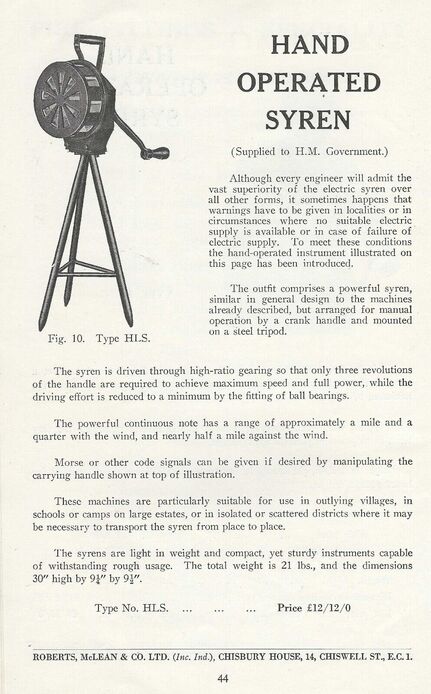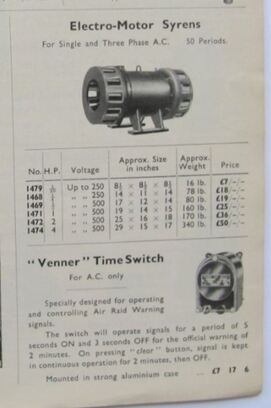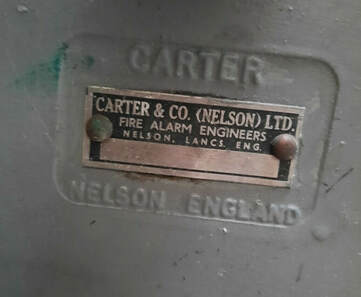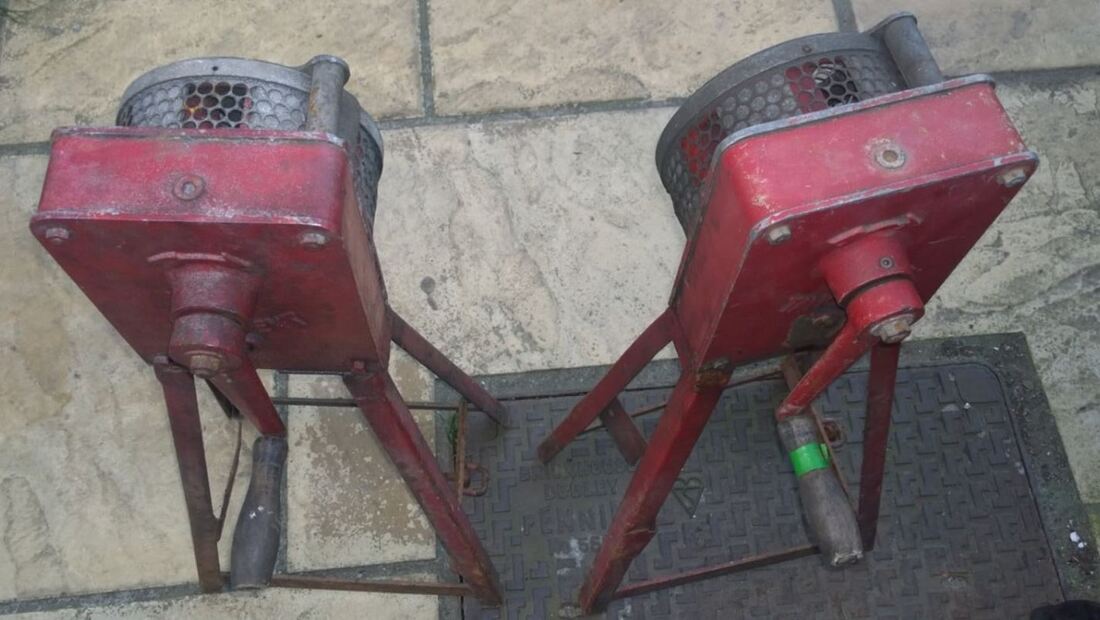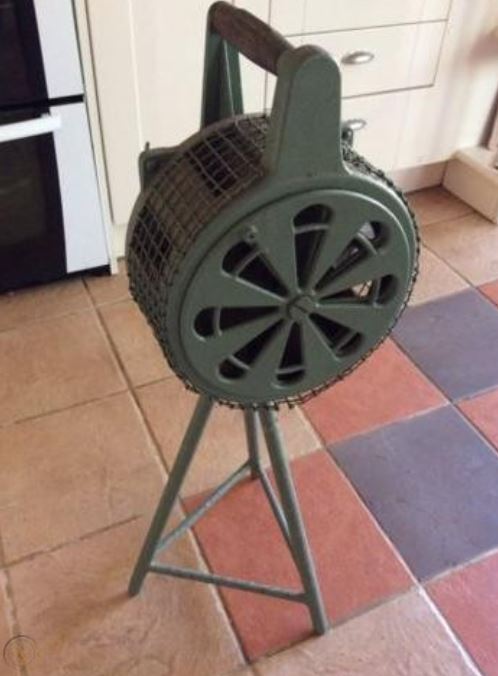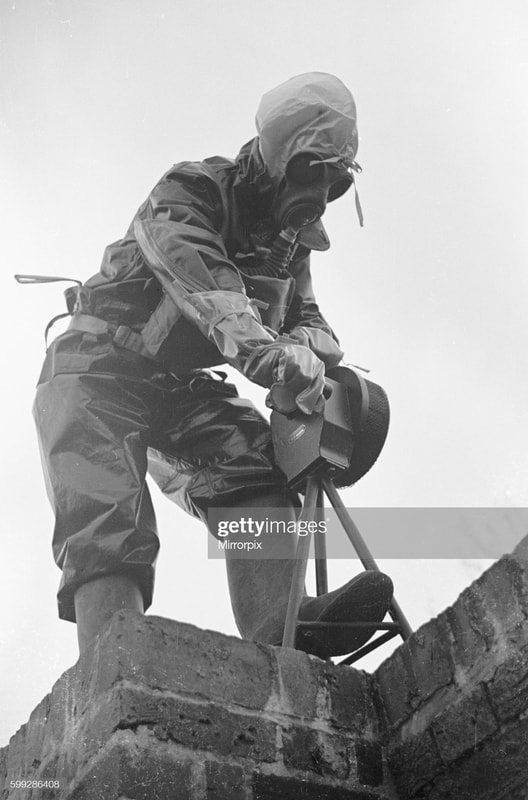WW2 Civil Defence Hand-Operated Air Raid Sirens
|
Little evidence exists of the use of hand-operated air raid sirens (also called hand-wound, cranked, portable and manually-operated sirens) outside of businesses during the second world war. The majority of people lived in urban areas which had electrically-powered sirens - in catalogues these are often called "electro-motor syrens" (syren was an alternate spelling of siren during the period). Many large businesses and factories also had electrically powered warning systems of connected sirens.
According to records (e.g. EPRG Pub. No. 1/94) hand-operated sirens were issued to some rural areas during the war. However, the Ministry of Home Security stated the use of air raid sirens in rural areas was not required as these areas were not a target and there were no air raid shelters for people to go to. British manually operated sirens had a crank that revolved in a clockwise direction. A twist grip on the top was used to steady the siren and also to operate the opening and closing of a vent that changed the siren's tone. A rising and falling tone to alert people to 'Take Cover' for an impending raid and a continuous siren tone for the 'All Clear' signal. It has been suggested that hand-cranked sirens were issued to Observer Corps posts (later the Royal Observer Corps (ROC) from 1941) but this is incorrect. The ROC did get sirens as a post-war measure. |
Electro-Motor Air Raid Siren (or Syren)
|
Local authorities installed electric-motor syrens (sirens) that would alert the populace to an incoming raid. Most were installed in the late 1930s as the country prepared for war. Various sizes of siren were available from various manufacturers with the largest used for urban areas as they could cover the greatest area.
|
Gents and Carter Hand-Operated Air Raid Sirens
|
There were a number of manufacturers of hand-operated sirens - Gents of Leicester and Carter of Nelson in Lancashire. There was a company called Leach in London that may also have produced sirens. Smaller hand-held sirens from a company called Klaxon are known but their usage appears to be for commercial purposes such as in smaller-sized factories.
Gents were and remain a business making electrical equipment. They made a series of hand-cranked sirens called "Tangent". They were painted grey and those in red may have been for use by fire services. These Tangent sirens had a four-legged base. |
A large number of Carter sirens are claimed to be WW2 vintage but the vast majority are actually from the Cold War. It would appear that Carter sirens carrying the "Home Office Property" or "Scottish Home Office Property" plates were made after 1945. These sirens have an angle-iron tripod. Examples from the war appear to have a tubular tripod (see below) and are much rarer to find. It is unknown if WW2 sirens were reissued in the Cold War but it seems unlikely.
Hand-cranked sirens in use
There are hardly any period photographs of hand-cranked sirens being used or stored during the second world war. As previously stated, the Ministry of Home Security stated the use in rural areas was to be discouraged as they were not a primary target of the Luftwaffe and people had no air raid shelters to visit.
A number of manufacturer's catalogues of ARP equipment list the electro-motor versions and hand-cranked versions. The majority of the hand cranked sirens are thought to have been bought by businesses that did not have an electrically powered siren installed.
There is one pre-war photo of an air raid exercise that shows a hand-cranked siren being used by someone dressed head-to-foot in anti-gas oilskins; it appears they are using a Carter-style siren with the tubular legs.
If you have any information on the use of hand-cranked sirens during the war or any photographs, please drop me a line via the Contact page.
A number of manufacturer's catalogues of ARP equipment list the electro-motor versions and hand-cranked versions. The majority of the hand cranked sirens are thought to have been bought by businesses that did not have an electrically powered siren installed.
There is one pre-war photo of an air raid exercise that shows a hand-cranked siren being used by someone dressed head-to-foot in anti-gas oilskins; it appears they are using a Carter-style siren with the tubular legs.
If you have any information on the use of hand-cranked sirens during the war or any photographs, please drop me a line via the Contact page.
Cold War Home Office Type 447 Air Raid Sirens by Carter & Secomek
All Carter and Secomek type 447 air raid sirens date from the Cold War, most manufactured in the 1960s. The Carter model is thought to have been a better model being more robust and using higher-quality bearings.
